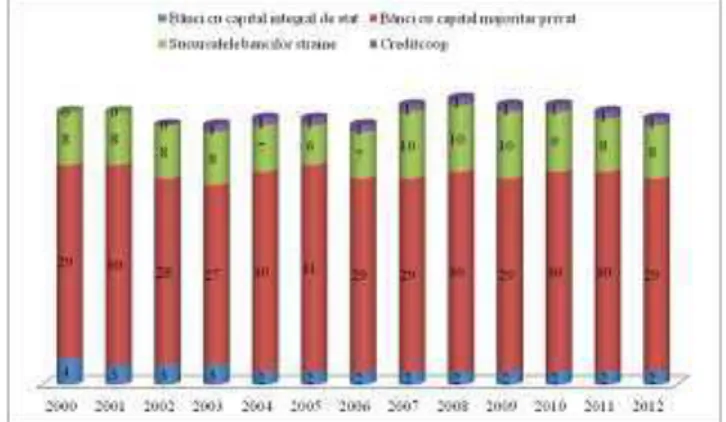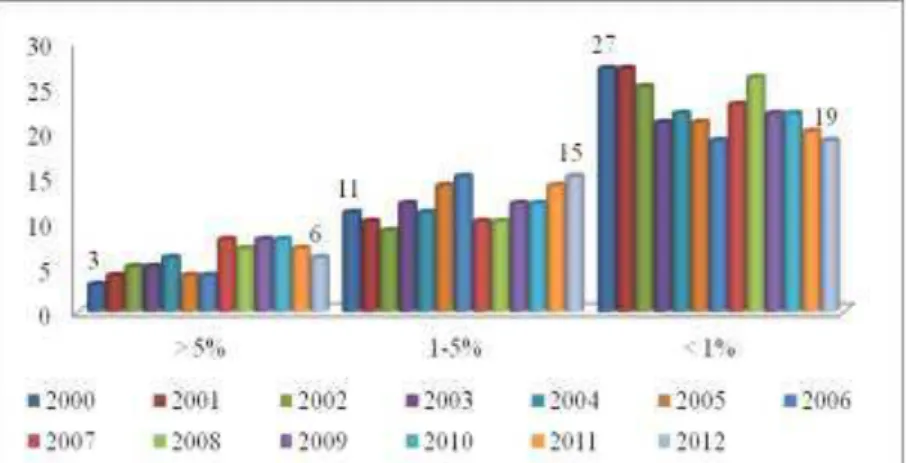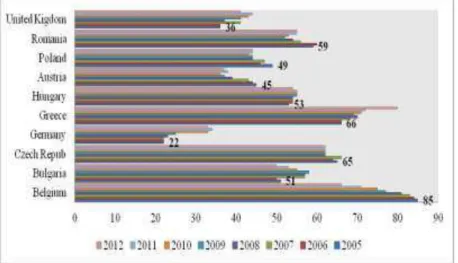GROWTH AND PROSPECTS OF SYSTEM BANKING IN ROMANIA
VLAD MARIANA
LECTURER PHD, UNIVERSITY OF SUCEAVA, ROMANIA,
marianav@seap.usv.ro
Abstract: The years of crisis were characterized by a moderation of the lending activity in Romania, banks have changed their focus from a rapid expansion towards a strategy determined by caution. The credit institutions have adapted the strategy, the territorial expansion plans, the product portfolio and switched to a more careful control of the operating costs.The purpose of this paper is to review status of the banking sector in Romania, compared with the data obtained in the EU countries. We will examine the structure indicators, the indicators measuring the degree of development and competition as well as the indicators measuring the performance of the banking system in Romania. The study period was 2000-2012.
Key words: bank system, Romania, market share, Herfindahl-Hirschman Index (HHI), return on asset, return on equity.
JEL classification: M41, M42
1. Introduction
This paper is organized in five sections. The 1st section describes the main significant moments that have marked the development of the banking system in Romania, also there were taken into account some indicators in order to analyze the structure, the degree of development and competition, and the performance of the banking system in Romania. The 2nd section analyzes, based on the data collected from the annual reports published by the Central Bank of Romania, which were major changes in the assessed period in the structure of the banking system in Romania, which were the factors that led to these changes, and which is the position of Romania in relation with other EU countries. The 3rd section emphasizes the degree of development and competition in the banking system in Romania, and the comparative analysis with other EU countries. The 4th section highlights the performance of the banking system in Romania. The performance was analyzed using the profitability indicators, namely: the ratio of annualized net profit and total assets at the average value (economic profitability or Return of Assets - ROA) and the ratio of annualized net profit and equity interests to the average value (financial profitability or Return of Equity-ROE). The 5th section concludes the article and provides the conclusions of the study findings.
In order to ensure an adequate environment for a functioning market economy, in Romania there has been a process of modeling the banking system, which aimed on the one hand, the creation of a modern banking system, specific to a market economy, and on the other hand, the harmonization of the Romanian banking legislation with the European legislation.
The restructuring process of the banking system started since the end of 1990, when the newly established Romanian Commercial Bank (BCR) took over the commercial function which was held by the National Bank. The former specialized state banks (Romanian Bank for Foreign Trade, Agricultural Bank, Investment Bank) have been transformed into commercial banks which could perform all the banking operations without considered their previous sectorial specialization. Thus, along with the adoption of the two banking laws - the Law on the Banking activity and the Law on the Statute of the National Bank of Romania, which entered into force on the 3rd of May 1991, there was enshrined the creation of a two-tier banking system, Western-type, based on the principle of the banks universality.
The privatization of the state-owned commercial banks in Romania has proven to be a difficult process, hardly in May 1997 there was adopted the Law on privatization of state-owned commercial banks. In August 1998 there was triggered the privatization of the Romanian Bank for Development - BRD (privatization which was concluded in
December 1998 by an intake of 51% by Société Générale) and Bancpost, followed by the privatization of the
Agricultural Bank, Commercial Bank, Bancorex and BCR in 2006. The restructuring process has also targeted the Savings Bank (CEC), which was reorganized starting from the 1st of July 1996 as a joint stock banking company, with the object of activity of attracting, retaining and capitalizing the savings of the population and of the availability of the legal entities, and of providing loans, trying also the privatization, which has not been achieved so far.
come from two channels of transmission. On the one hand, a higher degree of banking competition should result in lower monopoly power of banks, and therefore a decrease in banking prices. On the other hand, heightened competition should encourage banks to reduce their costs, that is, their cost inefficiencies. [8]
The performance measurement indicators of the banking system are:
The Financial Return(Return on Equity – ROE) is determined as the ratio between net profit and equity. „A business that has a high return on equity is more likely to be one that is capable of generating cash internally. Thus, the
higher the ROE the better the company is in terms of profit generation.” [7]. In the international practice, the standard level is between 15-20%.
The economic profitability (Return on Assets – ROA) is calculated as the ratio between net profit and aggregate
assets of banks. „In principle, ROA reflects the ability of a bank’s management to generate profits from the bank’s
assets, although it may be biased due to off-balance-sheet activities.” [1]. In the international practice, the standard level is between 1-2%.
2. Dynamics and structure of the banking system in Romania for the period 2000-2012
In this section we will analyze, based on data collected from the annual reports published by the Central Bank from Romania, which were major changes in the structure of the assessed period in the banking system in Romania, which were the factors that led to these changes, as well as which is the position of Romania in relation to other EU countries.
The simplest measure of market concentration is the number of credit institutions in the market. This measure simply conveys the number of choices available to consumers. [5]
In order to ensure an adequate environment for a functioning market economy, in Romania there has been a process of modeling the banking system, which aimed on the one hand, the creation of a modern banking system, specific to a market economy, and on the other hand, the harmonization of the Romanian banking legislation with the European legislation. The restructuring process of the banking system started since the end of 1990, when the newly established Romanian Commercial Bank (BCR) took over the commercial function which was held by the National Bank. The former specialized state banks (Romanian Bank for Foreign Trade, Agricultural Bank, Investment Bank) have been transformed into commercial banks which could perform all the banking operations without considered their previous sectorial specialization.
Figure 1. The structure of the banking system in Romania
Considering this fact and the data summarized in the analyzed period it is observed that the banking system in our country has significantly transformed. This aspect indicates that the banking system in Romania has undergone structural changes which reflected both the measures taken by the central bank in order to eliminate unviable operators and the appearance on the market of new banks, mergers or changes in the shareholding majority, which resulted in a steady increase in market share of foreign banks, along with the erosion of the monopolistic position of the state sector, but with a slight narrowing of the domestic private banking segment. Lately, in the banking industry there has been noted a trend of consolidation, this trend being evident in the decline of the number of the credit institutions (Figure 2)
Figure 2. The number of the credit institutions in EU countries
The decreased number of credit institutions in the EU countries reflects mergers rather than closing of the existing institutions. At the level of countries, comparing to 2005, the number of banks decreased by 16% in Greece, by 11.68 in Hungary and by 10% in Germany, mainly due to the restructuring of the banking sector (i.e., liquidations, acquisitions) while Slovakia has registered an increase by 21.7%, although in the dynamics is on a decreasing trend.
An important aspect to point out, with impact in changing the capital structure is that in 2013, due to the reclassification of some banks from the group of the banks with Romanian major capital into the group of the banks with foreign capital, the market share of banks with Romanian major capital has reduced by half, being inferior to the bank share with French and Greek major capital. The banks with Austrian major capital, own, similar to previous years, the largest market share in the banking system in Romania. Therefore, at the end of 2013, the market share in bank assets of bank system with major foreign capital, reached the value of 90.8 %.
We notice that some substantial changes in the ownership structure have occurred with the onset of the privatization process of the banks with state major capital. Considering the origin of capital, the banking system in Romania presented the following structure for the year 2012: only 2 banks with state major capital (CEC and Eximbank), 3 banks have Romanian private capital (Carpathian Commercial Bank, Libra Internet Bank and Railway Commercial Bank), and 34 were into the category of foreign-owned banks (including the branches of the foreign banks).
Figure 3. Foreign participants in the banks’ capital in Romania
However, although the podium was kept for so many years, the most significant change of the presence on the local market has returned to Greece, that, since 2008, has reached the first place in the ranking of foreign equity holdings in the banks from Romania. In 2012, Greece ranks the first investment place (with 21.2% of total capital), but maintains its descending trend began in 2010, when the share of the total banking system was of 25.5%, followed by Austria (with 20.8%) and the Netherlands (with 11.6%).
3. Degree of development and competition at the level of the banking system in Romania
In this section we have analyzed the degree of development and competition at the level of the banking system in Romania, and the comparative analysis with other EU countries. The data have been processed in accordance with the financial statements published by the Central Bank of Romania, and in accordance with those published by the European Central Bank.
This literature is essentially based on the assumption that concentration weakens competition by fostering collusive behaviour among firms. Increased market concentration was found to be associated with higher prices and greater than normal profits argue that higher profits in concentrated markets could be the result of greater productive efficiency. [2]
From a theoretical point of view, competition may have a deleterious impact on stability if it causes banks’ charter value to drop, thus reducing the incentives for prudent risk-taking behavior. [5]
The banking sector in Romania is characterized by a moderate degree of concentration, with a descending trend, which indicates a low level of competition. That is, namely, an oligopolistic structure. Out of the 40 existing banks at the end of 2012, 19 had together a market share by assets of less than 1%, according to Central Bank (BNR) data, other 16 banks had market shares between 1 and 5%, and only 6 credit institutions had a market share of more than 5%, last year (figure 4).
Figure 4. The structure of the banking system in Romania based on the market share of the assets of the banks
Figure 5. The share of assets held by the top five banks in the aggregate assets
From Figure 5 we observe that Romania maintains at a moderate level compared to other countries in the region. The relative decrease in concentration of the banking system in Romania reveals a tendency of increasing competition between credit institutions.
From a theoretical perspective, intense competition is assumed to lower intermediation expenses and contribute to the improvement of efficiency, at the cost of shortening the average duration of lending relationships and eroding banks' profitability. [4]
Figure 6. Competition measure - Herfindahl Index in EU countries
From graphic presented we notice that in the EU there are significant differences of concentration, Belgium having the highest rates of concentration, while the Czech and Greece are situated as countries with a moderate degree of concentration. Note that during the analyzed period Romania was situated until 2007 as a country with an average concentration rate, and since 2008, it was situated together with Germany, Hungary, and Poland with a low concentration rate. The Herfindahl-Hirschmann index calculated at the level of assets shows a level of concentration and ranks the banking system from Romania below the average registered by EU.
4. The performance of the banking system in Romania during 2000
–
2009
Figure 7. The evolution of the profitability indicators at the level of banking system in Romania
The main factors affecting the profitability of the banking system in Romania were: the interruption of the increasing trajectory of lending activity, the increase of the required provisions necessary to cover the credit risk and the increase of the borrowing and financing costs. We note that the banking sector in Romania has registered losses since 2011. The credit institutions in Romania have tried to alleviate the decreasing trend in profit by resizing the territorial networks, expanded aggressively in recent years, and adjusting the necessary personnel. Although the operating profit has improved, the European credit institutions continued to register rates of return situated significantly below the values registered prior to the crisis.
Conclusions
In the analyzed period, the Romanian banking sector continued to be well protected against various unfavorable developments that have occurred both locally and internationally. The phenomenon of tightening the lending activity registered in Romania is in line with the trends recorded in the euro area and in most countries in the region, given the background of the difficult macroeconomic developments at international level, affecting both the demand for credit and the lending standards and conditions practiced by the commercial banks. In terms of market share, in the Romanian banking system first places are occupied by banks with Austrian, French and Greek capital; the group of banks with Romanian capital has experienced a decrease in the share as a result of the reclassification of some banks. The degree of financial intermediation has recorded in 2012 a slightly descendent trend in conditions of poor lending activities. The degree of concentration of the banking system in terms of assets, as reflected by the share of top five banks in the system, is maintained at a moderate level compared to other countries in the region. The Herfindahl-Hirschmann index calculated at the level of assets shows a moderate level of concentration and places the Romanian banking system under the average of EU-27. The Romanian banking sector registered losses in recent years, as a result of the substantial increase in the volume of provisions related to credit risk due to the increase of the non-performing loans, respectively, of the reassessment of the guarantees.
The main challenges for the banking system in Romania for the next period, similar to the economies of most EU Member States are: resumption of lending under sustainable conditions, given a continuing and even intensifying financial deleveraging which occurs internationally, and a proper management of the bank assets quality, including by ensuring a functional balance between the costs and benefits of different management solutions for the non-performing exposures.
Reference
[1] Athanasoglou P., Brissimis S., and Delis M., Bank-specific, industry-specific and macroeconomic determinants of bank profitability, June 2005, Online at http://mpra.ub.uni-muenchen.de/32026/, MPRA Paper No. 32026, posted 5. July 2011 14:01 UTC
[2] Casu B, Girardone C., Bank Competition, Concentration and Efficiency in the Single European Market,
http://www.essex.ac.uk/ebs/research/efc/discussion_papers/dp_05-02.pdf
[3] Căpraru B., Activitatea bancară –sisteme, operaţiuni si practici, Editura C. H. Beck, Bucuresti, 2010,
[4] Gutiérrez de Rozas L., Testing for competition in the spanish banking industry: the panzar-rosse approach revisited, Spain, 2007,
[5] Koutsomanoli-Fillipaki N., Staikouras C., Competition and Concentration in the New European Banking Landscape, European Financial Management, Vol. 12, No. 3, 2006, 443–482, http://repec.org/mmfc04/26.pdf
[6] MacitT F., Recent evidence on concentration and competition in Turkish banking sector, Theoretical and Applied Economics Volume XIX (2012), No. 8(573), pp. 19-28
[8] Pruteanu-Podiera A., Weill L. and Schobert F., Banking Competition and Efficiency: A Micro-Data Analysis on the Czech Banking Industry, Comparative Economic Studies, 2008, 50, (253–273)
[9] www.bnr.ro



